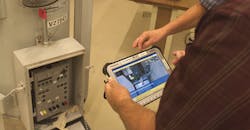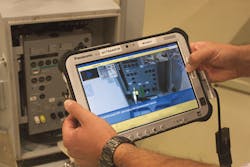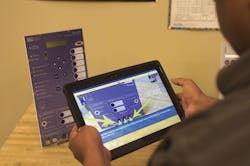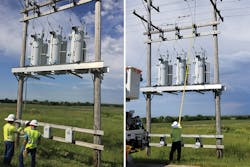Westar Energy Dives into Augmented Reality World
Many electric utilities nationwide face the same issue — how to capture knowledge and experience from veteran linemen and then transfer it to new apprentices. Through the world of augmented reality (AR), utilities now can build training apps that can be used on a variety of mobile platforms to deliver training electronically.
For example, Westar Energy Inc., the largest electric utility in Kansas with 700,000 customers, partnered with Index AR Solutions, an enterprise AR solutions provider, to launch the LineAssist SuperApp. According to the vendor, which offers custom and off-the-shelf AR applications and proprietary software, this app transforms how linemen are trained in the classroom and do work in the field. Using a mobile tablet, linemen can access detailed step-by-step directions through AR. The imagery is overlaid on the utility structures workers might come across on a service call, and safety warnings, 3-D animations and written instructions are built into the app. As such, linemen can visualize and more easily perform unfamiliar tasks, and Westar can reduce its number of truck rolls.
Deciding on an Application
Half the electricity supplied to Westar’s 700,000 customers stems from emissions-free sources such as nuclear, wind and solar with a third coming from renewables. Westar coordinates a network of lines and substations that support one of the largest consolidations of wind energy in the nation.
To manage their work flow, Westar’s substation maintenance craft workers have been using tablets to enter labor hours and work orders into the work management system since 2012. Westar just rolled out tablets to its distribution line crews within the last year, and the linemen use the mobile technology to receive their work assignments, tap into the work asset management system and access mapping data to pinpoint their work locations.
After investing in the tablets, Westar’s forward-looking CEO wanted to explore other technologies. As such, he asked his team to look at AR to see if it made any sense for the utility, and if so, what benefits it might offer to the field workforce. He then connected the leaders of Index AR with the Westar team.
To decide on this particular application, Westar pulled together a cross-sectional team and brainstormed ideas of where and when it could use AR. Some applications they considered involved load tap changers, smart meter data, power plant generators and Limitorque valve actuators.
Westar opted to focus on voltage regulator maintenance during its pilot project to test whether it could gain efficiencies using AR. Traditionally, when Westar has an issue with a line voltage regulator, a troubleshooter serves as a first responder and assesses the location of the problem. If the issue lies with the voltage regulator, he or she will turn it over to a line crew, but if it is a problem with the controller, the troubleshooter will turn it over to a substation relay technician.
It is not uncommon to have two or three truck rolls for a voltage regulator issue. Even though the issue may be minor, most troubleshooters don’t have the experience with all the different models of controllers to make repairs like the relay technicians.
Troubleshooting Controllers
After zoning in on a topic for the app, Westar brought in subject-matter experts who mapped out the processes for troubleshooting and maintenance. These experts worked directly with the programmer for Index AR.
Over time, the team created several different iterations of the app. The programmer would create a version for review, and then the Westar team would review it and make suggestions for the next version.
Next, the utility selected a small subset of line craft employees to test the voltage regulator maintenance app and identify any issues before implementing a wide-scale deployment.
Westar is now in the process of rolling out the app to its field workforce to try to improve productivity in the field. For example, when a troubleshooter discovers a voltage regulator that is not working, he or she can simply point the tablet at the controller. The voltage regulator can recognize the pattern of the buttons on the controller and identify the exact model. Next, the app brings up the troubleshooting steps for that specific controller.
Westar has five different models of controllers, and Index AR programmed the steps for each of those different models.
When using the LineAssist SuperApp, Westar’s employees can also access a set of maintenance best practices for pole-mounted voltage regulators. That way, the linemen can visualize each step of the process and more easily and safely get their job done.
The app will walk a troubleshooter through the steps for a particular model of controller. Through AR, it shows the troubleshooter exactly which button to flip and where to plug in the probes for a meter. The app features embedded photos and videos of a craftsman performing the work during certain steps.
In addition, the app includes access to all of the reference material for the task at hand. That way, if the craftsman out on the job wants to dig into the operations or maintenance manual, he or she can search for a particular section for assistance.
Saving Time in the Field
While it’s still early in the rollout, Westar Energy is expecting to quickly see benefits from the app. For example, in its substation maintenance department, it typically has eight callouts a month. For each of these callouts, the utility had to disrupt the work of a relay technician to drive to a site and work on a line voltage regulator. Through the AR app, Westar expects to cut the number of those truck rolls at least in half, realizing significant savings and return on investment.
After rolling the app out slowly, Westar plans to bring the team back together to see if there is another app that it wants to invest in. Also, the utility is interested in reviewing other apps that have been developed by other utilities as well. In the meantime, Index AR is also developing other AR applications within its SuperApp library to help workers to perform complex maintenance tasks more quickly and safely.
So far, Westar’s field workforce has responded positively to the new app. Troubleshooting a controller is a highly technical task that is not done very frequently, and as such, it can be hard for a worker to be able to maintain proficiency with limited experience.
By using the mobile training and field app, however, the troubleshooters now have technology at their fingertips. The app integrates the knowledge of Westar’s veteran craftsmen and delivers it through technology to Westar’s line crews. That way, the utility can reduce the number of truck rolls and streamline a maintenance process, thereby saving time for the field crews and ensuring the work is done safely and efficiently.
Dave Claussen ([email protected]) is the senior director of substation construction & maintenance for Westar Energy, which recently merged with Kansas City Power & Light Co. to form Evergy. He has been in the industry for about 30 years and started as a lineman for the National Guard while earning his engineering degree. Prior to Westar, he worked for Central Illinois Light Co.
About the Author
Dave Claussen
Senior Director of Substation Construction & Maintenance
Dave Claussen is the senior director of substation construction & maintenance for Westar Energy, which recently merged with Kansas City Power & Light Co. to form Evergy. He has been in the industry for about 30 years and started as a lineman for the National Guard while earning his engineering degree. Prior to Westar, he worked for Central Illinois Light Co.



